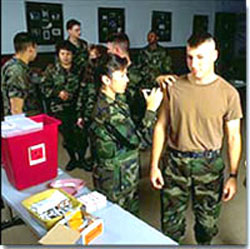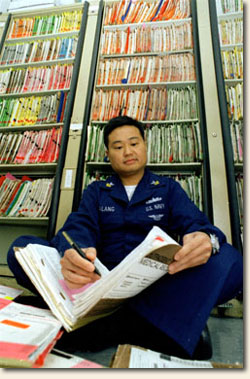|
Many Gulf War veterans have experienced
a variety of physical symptoms and illnesses in the years since
the Gulf War. In response to veterans' concerns, the Department
of Defense established a task force in June 1995 to investigate
incidents and circumstances during the war that might be related
to veterans' symptoms. The Office of the Special Assistant - now
known as the Deployment Health Support Directorate - assumed responsibility
for these investigations on November 12, 1996, and continues to
gather information on medical questions and issues related to the
troops who served there.
To inform the public about the progress
of this office, the Department of Defense (DoD) publishes on the
Internet and elsewhere accounts related to the possible causes of
medically undiagnosed physical symptoms among Gulf War veterans,
along with documentary evidence or personal testimony used in compiling
the accounts. The following is a summary of the reports we have
published concerning our investigations into medical issues and
providing information related to illnesses of Gulf War veterans.
 |
Concern by some Gulf War veterans that vaccines
may have contributed to their unexplained illnesses led to
the vaccine use study. |
Vaccinations
Since their return from Southwest
Asia for Operations Desert Shield and Desert Storm, some US military
personnel have developed medically undiagnosed physical symptoms
that may relate to their service during their deployment. A number
of veterans and others have expressed concern that the use of vaccines
may have contributed to these symptoms. The Special Assistant examined
this issue, and in December 2000, published the Vaccine
Use During the Gulf War information paper, which addresses military
vaccination policies and practices during and after the Gulf War,
as well as plans for future deployments.
Vaccines are commonly-used health
interventions that broadly benefit populations, as well as individuals.
Because of its unique and diverse mission, the military employs
vaccines as critical countermeasures against infectious diseases
and biological warfare agents. Differences in vaccination policies
among the military services reflect variations in their respective
training cycles, missions, and expected levels of exposure. Military
vaccine programs are also constantly updated to incorporate advances
in preventive medicine, as well as in response to changing health
threats.
During the Gulf War, anthrax and botulinum
toxoid vaccines were used to protect US forces against the threat
of Iraq's biological agents. Administration of these vaccines during
Operations Desert Shield and Desert Storm was characterized by several
difficult issues: lacking sufficient quantities of the vaccines;
prioritizing military units for vaccination; using the investigational
botulinum toxoid vaccine; obtaining informed consent; providing
Service members with information about the vaccines dealing with
operational security considerations; and documenting vaccines in
health records.
Military personnel today are facing
increasingly routine deployments overseas, exposures to environmentally
hazardous battlefields, and risks associated with biological warfare
agents. The Gulf War experience has brought shortfalls in vaccine
administration to light and generated improvements in force health
protection. Ensuring adequate production sources and maintaining
sufficient stockpiles of safe and effective vaccines - especially
vaccines in investigational status - remain daunting challenges,
as does the communication of associated health risks to Service members.
Importantly, progress has been demonstrated in vaccine tracking
and documentation for deployments, and robust research on military
vaccine development is ongoing. The Department of Defense should
continue to build upon lessons learned from the Gulf War to ensure
that advances in vaccine development and administration keep pace
with changing health threats to military personnel.
Medical Recordkeeping During
the Gulf War
Following the return of American Service members
deployed to Southwest Asia during Operations Desert Shield and Desert
Storm, veterans reported physical symptoms that believed may have
been related to their service in the Gulf War, yet defied medical
diagnoses. Medical records from this deployment did not provide
substantial support in explaining these symptoms. The Special Assistant
examined this issue and in August 1999, published the Military Medical Recordkeeping During and After the Gulf War
information paper. This paper addresses recordkeeping policies and
practices before, during, and after the Gulf War.
 |
The Gulf War experience taught us that it
is not enough to simply care for casualties; we must fully
document health care to better address Service members' and
veterans' post-deployment health concerns.. |
Military medical recordkeeping policies
at the time of the Gulf War tended to be service-specific and published
by the respective military Surgeons General. Prior to Operations
Desert Shield and Desert Storm, these policies focused almost exclusively
on the care of deployed forces during peacetime and less with recordkeeping
under deployment conditions. During the Gulf War, some services
deployed with abbreviated health records, while others typically
deployed with their full, original records. The Department of Defense
issued supplemental guidance on the documentation of immunizations
(anthrax and botulinum toxoid) that were investigational or required
some measures of operational security. Analysts with the Special
Assistant found documentation of deployment medical information
in individual health records to be problematic, mainly due to post-service
disposition policies.
Post-Gulf-War medical recordkeeping
policy continues to be made for each military service and the military
health system as a whole. The Department of Defense (Health Affairs),
the Joint Staff, and the military medical services are increasingly
focusing on force health protection and the documentation of medical
surveillance activities in support of continuing operational deployments
in Bosnia, Kosovo, and Southwest Asia. Cooperation has also increased
among the Department of Defense, the Department of Veterans Affairs,
and the National Archives and Records Administration on issues involving
the transfer and storage of medical records.
Groundwork continues for the development
of an automated deployment health information device (e.g., a personal
information carrier or "medical dog tag"), as well as a computer-based
patient record system for all military beneficiaries. The Department
of Defense views these as technological solutions to both the medical
recordkeeping deficiencies associated with the Gulf War and a presidential mandate to create a force health protection
program incorporating a comprehensive medical record for each military
Service member.
While DoD has progressed in the addressing
of medical recordkeeping shortfalls associated with the Gulf War,
work continues on the significant challenges of documenting health
care and other health-related matters associated with military deployments.
Information Capture of Data
from Gulf War Hospital Inpatient Records
 |
Data from over 28,000 records of admissions
to US military hospitals in the KTO and evacuee admissions
to hospitals in Germany was entered in the Inpatient Treatment
Records Database. This database will help further medical
research into undiagnosed illnesses of Gulf War veterans. |
Responding to concerns raised by veterans,
the Department of Defense, the Department of Veterans Affairs, and
other organizations both inside and outside of government have conducted
investigations into possible causes of medically undiagnosed physical
symptoms in Gulf War veterans. All of these investigations have
one thing in common: they examined illnesses that have been identified
and diagnosed, and reported symptoms during the post-Gulf-War period.
However, a large grouping of records and documentation for illnesses
and injuries unequivocally attributed to service during the Gulf
War had not been studied. These were the surviving hospital inpatient
treatment records from the Gulf War archived at the National Personnel
Records Center (NPRC) in St. Louis, Missouri. In June 1998, the
Special Assistant began an effort to establish an Inpatient Treatment
Records Database inventory of all Gulf War inpatient hospital treatment
records archived at the NPRC. Efforts to locate, document, and inventory
these records concluded in October 1999, with approximately 28,000
records identified and inventoried. With this new database, veteran
contact managers within the Special Assistant assisted Gulf War
veterans in obtaining copies of an existing inpatient record for
the purpose of assisting to establish eligibility for VA benefits.
In January 2000, the Special Assistant
directed a theater-wide review of inpatient treatment records be
conducted archived at the Records Center. The data capture operation
was conducted at the NPRC's research facility in St. Louis, from
November 2000 through May 2001. At the conclusion of the operation,
the Gulf War Inpatient Record Database contained 28,007 records
of admissions to US military hospitals in the Kuwait theater of
operations (KTO) and evacuee admissions to hospitals in Germany.
For this study, KTO unit location data was linked to each US military
patient. Unit location data is maintained and provided by the US
Armed Services Center for Unit Records Research (CURR). By linking
the patient diagnosis with the date of admission with the unit location
data, the analysts at Special Assistant were able to produce an
"epidemiological snapshot" of US troops deployed for Operations
Desert Shield and Desert Storm.
Deployment Health Surveillance
 |
Deployment Health Surveillance ensures a
fit and healthy force. |
The goal of deployment health surveillance
is to ensure a fit and healthy force and to prevent illness, disease,adverse
stress responses, and injuries from degrading mission effectiveness.
As defined by the Centers for Disease Control and Prevention, health
surveillance is the ongoing, systematic collection, analysis, and
interpretation of health data essential to planning, implementation,
and evaluation of public health practice. Medical surveillance of
all Service members before, during, and after military deployments
is mandated by Public Law 105-85, Section 765. The Deployment Health Support
Directorate seeks to facilitate the operational awareness of Deployment
Health Surveillance in today's military medical system.
Several new memorandums and directives
provide procedures for conducting health surveillance in support
of deployments. These include:
- Department of Defense Directive 6490.2: This directive
establishes the policy for routine joint medical surveillance
for all military members during deployments and designates the
Secretary of the Army as the Executive Agent for medical surveillance
during deployments.
- Department of Defense Instruction 6490.3: This instruction
institutes the policy, prescribes procedures, and assigns responsibility
for joint military medical surveillance in support of deployments.
Additionally, it describes medical surveillance activities during
major deployments, or those in which there is a significant risk
of health problems.
- Joint Staff Memo on Deployment Health Surveillance and Readiness:
This memorandum specifies the Joint Chiefs of Staff standardized
procedures for assessing health readiness and conducting health
surveillance in support of unified command deployments.
The Assistant Secretary of Defense
(Health Affairs) issued a policy memorandum requiring both pre-
and post-deployment health questionnaires in order to assess a Service member's
state of health before and after deployment. The Pre-Deployment Health Assessment (DD 2795) should be administered
at the Service member's home station or at the mobilization processing
station before deployment. The Post-Deployment Health Assessment (DD 2796) should
be administered before exiting the theater of operations. Copies
of the health assessments are to be placed in the Service member's
permanent medical record.
Additional Information Sources
The following web links provide additional
information related to medical and health-related issues facing
today's DoD Service members.
- Army Medical
Surveillance Activity (AMSA): AMSA is the central resource
for the Army providing regularly scheduled epidemiological analyses
and reports to policy makers, medical planners, and researchers.
It identifies and evaluates obstacles to medical readiness by
linking various databases that communicate information relevant
to soldiers' experience that has the potential to affect soldiers'
health.
- Composite
Health Care System II (CHCS II): This DoD (Health Affairs)
web site is a medical and dental clinical information system that
will generate and maintain a comprehensive, life-long, computer-based
patient record for beneficiaries under the Military Health System
(MHS). CHCS II enables the MHS to determine the deployment status
of units, demand management effectiveness, and disease prevalence,
management and outcomes.
- Deployment Medication Information Sheets: The Deployment
Medication Information Sheets are provided to Service members with
information on vaccines and other preventive medications they
will receive in preparation for movement and/or during deployment.
- Deployment Environmental
Surveillance Program: The US Army's Center for Health Prevention
and Preventive Medicine formed the Deployment Environmental Surveillance
Program (DESP) in 1996 to serve as a single point of contact for
deployment environmental surveillance issues as part of the Center's
Executive Agency for medical surveillance databases and deployment
surveillance analysis. The DESP's mission is to develop a system
capable of providing commanders and other decision makers pertinent
information needed to detect, assess, and counter environmental
threats as part of a Comprehensive Military Medical Surveillance
Program (CMMS). The strategic goal of the CMMS program is to allow
commanders and preventive medicine personnel to determine the
most likely causes of disease and non-battle injuries and focus
intervention efforts towards high risk areas under the overall
force health protection for deployed US Forces.
- HOOAH 4 HEALTH: This web site is specifically designed
to address the force health protection and readiness requirements
of the US Army and its Reserve Component. The HOOAH 4 HEALTH program
centers around four elements: body, mind, spirit, and environment.
- The Official DoD Anthrax Information Web Site: This DoD
web site holds comprehensive information on the anthrax disease
and its vaccine provided for US military forces.
- US Navy Deployment Medical Surveillance Homepage: The
US Navy Bureau of Medicine has designated the Naval Environmental
Health Center as the lead agency of deployment medical surveillance
issues within the US Navy. This office specializes in deployment
issues including entomology, environmental health, and epidemiology.
|

